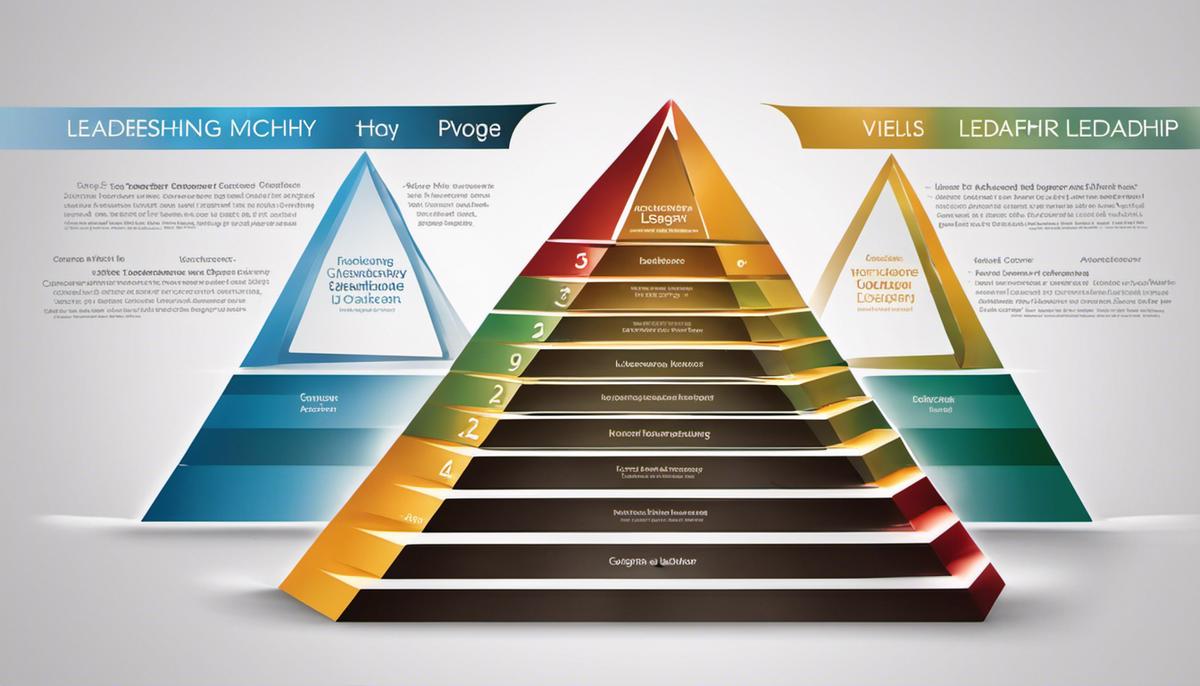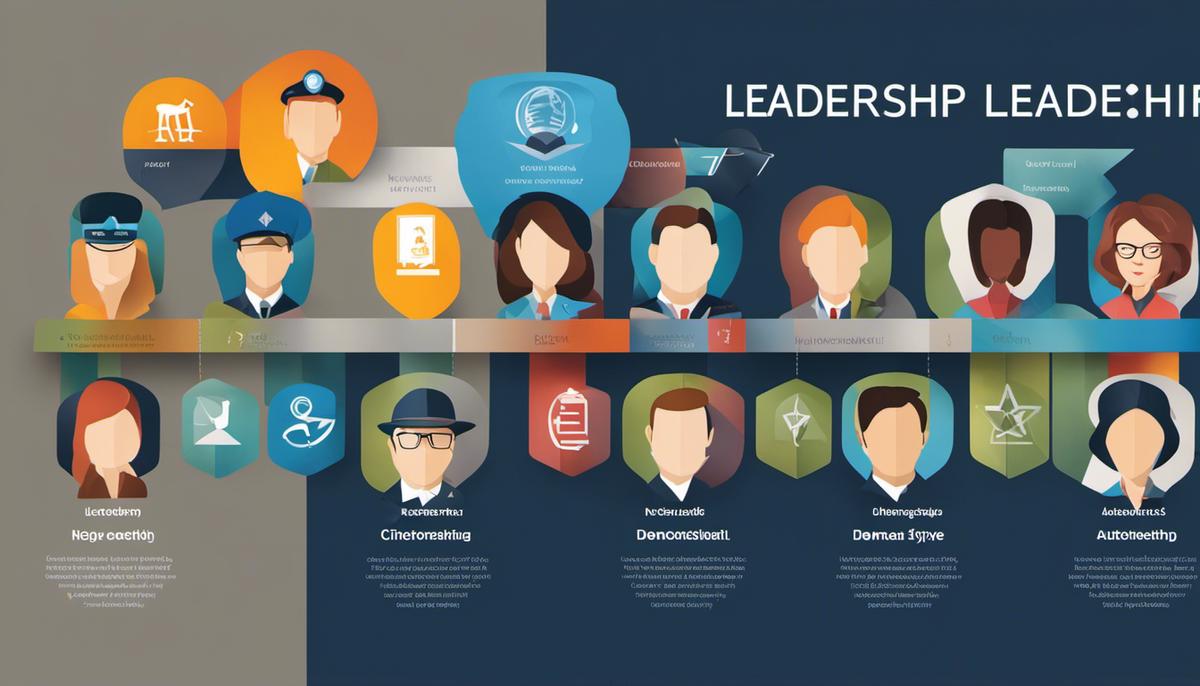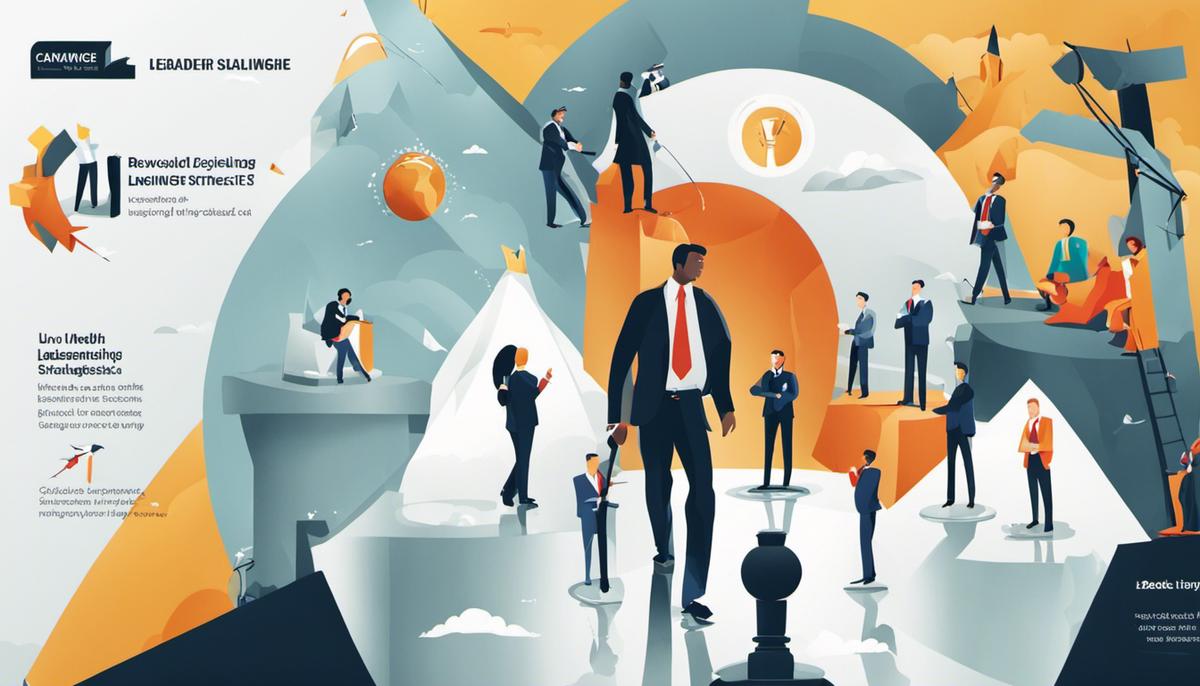Leadership is the single most significant influence on an organization’s potential to grow and thrive. It’s the difference between teams who work seamlessly to achieve impressive results and those that struggle to meet basic objectives. However, the realm of leadership is multifaceted, involving an intricate understanding of various levels, each demanding a unique skill set and approach. A deep insight into these levels and a mastery of the transition between them can facilitate a smooth voyage through the turbulent world of leadership. Alongside the exploration of different leadership styles and their applicability, this piece also dissects the challenges inherent at each leadership level, proposing effective strategies for overcoming them and encouraging personal development.
Understanding Leadership
Understanding Leadership: An Overview
At its core, leadership is the art of motivating a group of individuals to act toward achieving a common goal. It serves as the catalyst that propels any organization or team to its success. Since ages, leadership has assumed a key position in various sectors such as education, healthcare, technology, military, conservation, community development, and more. Effective leadership is pivotal in managing workforce diversity, foster a conducive work environment, encourage innovation, nurture talent, and drive an organization’s mission.
The Importance of Leadership in Different sectors
In education, strong leadership plays a pivotal role in shaping a child’s future. School principals, for instance, implement policies, motivate staff and students, and create an atmosphere conducive to learning. In healthcare, effective leadership is critical in patient safety, resource management, and healthcare policy implementation. Without good leadership, a tech startup might flounder dealing with market competition and rapid changes. In the military, leadership can quite literally be a matter of life and death. It is needed to strategize, combat, and defend a nation. Conservation leaders are required to drive change, influence public policy, and ensure sustainability.
How Leadership Contributes to the Success of an Organization
The role of leadership in an organization’s success cannot be overstated. Leaders have the power to inspire, motivate, and encourage employees to give their best. They play a vital role in setting the organization’s culture, which ultimately leads to overall profitability and growth. A leader also provides guidance, which is crucial during times of uncertainty and disruption. Further, leaders help in the formulation and implementation of new strategies and policies.
Basic Skills and Attributes of a Good Leader
A good leader possesses several critical skills and attributes. These include a clear vision, ability to communicate effectively, high emotional intelligence, resilience, adaptability, determination, and ability to inspire and motivate others. They should also exhibit honesty and integrity, and ability to take calculated risks, manage and resolve conflicts, and acknowledge and learn from their mistakes.
Leadership: Theories and Research
According to the Great Man leadership theory, leaders are born, not made. It suggests that individuals possess inherent traits that make them better suited to leadership. Conversely, the Transformational leadership theory argues that good leadership can be taught and developed. This approach focuses on motivating and transforming the group.
Recent research in leadership emphasizes the importance of charismatic leadership that inspires followers through personal charm and attractions rather than coercion. Servant Leadership is another researched leadership style stressing on the needs and development of the follows and putting their interests first.
Leadership functions as a commanding instrument that can determine a company’s future. By grasping the multiple tiers and forms of leadership, professionals can construct a work environment that fosters engagement, innovation, and accountability. These conditions, in turn, promote the overall success of the organization.

Levels of Leadership: From Basic to Advanced
Comprehending the Hierarchical Stages of Leadership
The skills associated with leadership often fall into various tiers, distinguished by the breadth of responsibilities, decision-making power, strategic contribution, and extent of influence. These stages extend from front-line supervisory roles right up to the top echelons, embodying the chief executive officers or managing directors situated at an organization’s strategic summit.
Frontline Leadership
At the bottom tier of the leadership pyramid, front-line or first-level leaders manage and supervise non-managerial staff directly involved in productive work or services. This tier includes roles like team leaders, supervisors, and shift leaders. The core duties typically revolve around task delegation, performance monitoring, issue resolution, and directly ensuring the quality of goods or services. Accordingly, abilities such as communication skills, team management, problem-solving abilities, and proficiency in the job are crucial at this level.
Middle-Level Leadership
Next, the middle-level leaders, or mid-managers, hold positions such as department head, branch manager, or project manager. They communicate the strategic objectives set by top-level leadership down to the first-level managers. Simultaneously, they provide top leadership with ground-level progress, feedback, and recommendations. Duties extend beyond day-to-day operations to longer-term activities such as resource management, team training, setting departmental goals, and aligning them with organizational objectives. Hence, this level demands skills like strategic planning, motivational leadership, financial acumen, and an understanding of cross-departmental relations.
Senior or Top-Level Leadership
As we move higher in the leadership structure, we encounter senior or top-level leadership. This includes executive roles such as CEO, President, or Vice President roles, who are responsible for making the most significant decisions about the entire organization and its direction. They are charged with setting the strategic vision, managing external relations, driving innovation, and influence overall organizational culture. At this level, advanced skills like strategic foresight, transformative thinking, crisis management, and stakeholder relations are most essential.
Case Study: Apple Inc.
To visualize these levels, consider the case of Apple Inc. At the frontline level, a store manager focuses on task supervision, resource allocation, and in-store customer service. The regional manager, at the middle level, is responsible for streamlining operations across multiple stores and aligning them with corporate directives. At the top level, the CEO, currently Tim Cook, sets company-wide strategies, ensures shareholder satisfaction, and fosters a culture of innovation and excellence across Apple.
In Summary
The layered notion of leadership levels provides an intricate understanding of how control is exercised in organizations. Scaling up this ladder, one’s sphere of influence inherently expands, there is an elongation and enlargement of decision-making capacity, and the required skill set becomes increasingly strategic and sophisticated. Keen mastery of these different leadership levels is a sine qua non for any professional aiming to sharpen their leadership prowess or raise their organization’s effectiveness.

Transitioning Between Leadership Levels
Deciphering the Various Leadership Levels
Foundation Level – Leading Self: The scaffolding for leadership is built on self-leadership. At this level, elements such as self-control, dependability, and self-conception form the base that establishes confidence and authenticity in others. Top-grade leaders are competent in managing their time, enhancing their abilities, and controlling their reactions and conduct. These leaders set the standard with their solid work discipline, integrity and serve as role models for those coming behind them.
Intermediate Level – Leading Teams: Progressing to this rank, leaders bear the accountability of guiding a team. The role necessitates the capability to inspire, stimulate, and interact effectively with diverse personalities. At this juncture, emotional intelligence, the skill to delegate tasks, and the capacity to provide and accept feedback become vital.
Advanced Level – Leading Leaders: At this stage, these leaders take on the mantle of guiding other team leaders. This stage requires the ability to focus on the macro perspective, lay down and convey strategic objectives, foster a collaborative atmosphere and facilitate the autonomy and efficiency of other leaders.
Top Level – Leading Organizations: This is the pinnacle of leadership, where leaders steer entire departments or even entire corporations. It demands a strategic foresight, decision-making precision, resilience and emotional intelligence. Effective top-level leaders are expected to pilot change, instill a common vision, traverse complexity, and foster a robust organizational culture.
Transitioning Between Leadership Levels
From Leading Self to Leading Others
To transition from the first to the second level, individuals must shift focus from themselves to others. They must enhance their communication skills and boost empathy levels to motivate and inspire the team. Patience and the ability to give constructive feedback are also vital traits to develop during this phase. Leaders must strive to understand the strengths and weaknesses of individual team members and delegate tasks accordingly.
From Leading Others to Leading Leaders
Transitioning from leading others to leading leaders involves a perspective shift from managing teams to managing managers. Emphasizing strategic thinking, fostering independence, and driving organizational alignment, are essential skills to develop. Leaders need to ensure their managers have the right resources and are equipped with decision-making skills. Open communication and collaboration are also necessary to align with the organization’s vision and goals.
From Leading Leaders to Leading Organizations
Ascending from this level demands a shift from managing managers to leading the entire organization. Leaders need to cultivate a broad strategic outlook, display a resilience to change, and champion innovation. Success at this level depends on the leader’s ability to build a strong culture, engage with diverse stakeholders, influence beyond their direct authority, and steer the organization with a long-range perspective.
Transition Challenges and Key Strategies
Shifting between different levels of leadership isn’t always easy. Resistance to change, imposter syndrome, and a sense of isolation are just a few of the obstacles that may appear. For a smoother transition, leaders need to cultivate resilience, embrace ambiguity, and build strong support networks.
With a clear understanding of the requirements and expectations of each leadership position, transition becomes less daunting. Through mentorship or coaching, continual learning, and adaptability, leaders can navigate these transitions with confidence. Embracing a growth mindset, seeing value in new experiences, learning from mistakes, and adjusting strategies based on evolving circumstances can pave the way for successful leadership transitions.
Developing strong relationships is vital at any level of leadership, but it takes on heightened importance as one rises through the ranks. Alliances not only buffer the impact of change but also facilitate access to necessary resources and provide essential support for decision-making and problem-solving.
Remember, though, successful transition doesn’t solely rest on an individual’s shoulders. Organizations also play a significant role. By offering resources like training programs, workshops, and leadership development initiatives, they can set up their leaders for success and facilitate smoother transitions.

Leadership Styles and Their Applicability
Discovering the Spectrum of Leadership Styles
When it comes to leadership styles, they are often categorized into distinct types such as autocratic, democratic, and transformational. Each style holds unique qualities and decision-making tactics, the application of which depends on the specific business circumstances or environment. Understanding these styles not only furthers our comprehension of leadership dynamics, but also equips us to more effectively navigate our own leadership paths and transitions.
Autocratic Leadership
Autocratic leadership, sometimes referred to as authoritarian leadership, is characterized by individual control over all decisions and little input from group members. In an autocratic leadership environment, the leader makes decisions without consulting with others, and their authority is not typically challenged. This leadership style can be effective in fast-paced industries or environments where decisions need to be made quickly and decisively, or in situations where team members are inexperienced or require a strong directive leadership.
Democratic Leadership
Another style of leadership is democratic or participative leadership. In this style, leaders share decision-making responsibilities with team members, promoting participation and collaboration. Team members are encouraged to share their thoughts and ideas, fostering creativity and freedom of expression. This style of leadership can foster high job satisfaction and is conducive to a positive work environment where everyone feels valued and heard. Democratic leadership can be particularly effective in creative industries, or in areas where teamwork and collaboration are key.
Transformational Leadership
Transformational leadership is a style where leaders inspire their followers to achieve unexpected or extraordinary results. It is often the preferred style of leadership for dynamic and rapidly changing environments. Leaders adopting this style are typically charismatic, inspirational, and passionate, able to motivate team members to exceed their personal interests for the greater good of the team or organization. This style often produces higher productivity and performance due to the influence and inspiration of the leader.
Situational Leadership
Situational leadership is a style where the leader adjusts their leadership approach based on the specific situation, individual, or team they are leading. This style requires a high level of flexibility and understanding of team dynamics, as well as the ability to recognize and adapt to the changing needs of a team or situation. Situational leadership can be applied effectively in a myriad of business environments, as it leverages the strengths of team members while adjusting to overcome weaknesses or challenges.
Leadership Styles and Levels of Leadership
Effective leadership styles can vary based on different levels of leadership in an organization. Frontline or supervisory leaders may find a more autocratic or transactional style to be effective in ensuring daily tasks are completed effectively, while middle-level or senior leaders may find more success with transformational or democratic leadership styles that prompt strategic thinking and creativity.
Effective leadership requires not just recognizing one’s primary leadership style, but understanding the strengths and weaknesses that style holds. Moreover, it’s essential not just to be conversant with other leadership styles, but fluent in shifting between them depending on the situation at hand or the specific needs of the team being led. The key to achieving superior leadership is found in studying how to balance between these styles and use them to best effect to boost team productivity and nurture strong professional relationships.

Dealing with Challenges at Different Leadership Levels
Challenges of First-Level Leadership: Frontline Managers
Frontline managers, recognized as first-level leaders, face the unique challenge of transitioning from functioning as individual contributors to acting as team leaders. This progression isn’t easy – it demands acquiring skills, assuming responsibilities, and, often, managing people who were once just peers. At the same time, these leaders still need to engage in the daily operations of their respective departments.
Many frontline managers find this adaptation process daunting, as it calls for a fresh approach to decision-making and delegation, along with heightened organizational awareness. For the smooth transition into their new role, these leaders need to hone their communication, problem-solving, and people skills. Mastery in these areas will enable them to effectively lead their teams.
Second-Level Leadership Challenges: Middle Managers
Middle managers, also known as second level leaders, deal with their unique set of challenges. They are responsible for large functional areas that can include multiple teams managed by first-level leaders. Their primary challenges stem from having to balance the pressures from top leadership with the realities on the ground.
These managers often grapple with resource constraints, goal alignment, and cross-functional coordination. They must ensure their departments meet operational targets, align with strategy implementation, and achieve overall business goals. This requires a dynamic ability to translate strategy into operational plans, manage conflicts, and lead change to drive organizational performance.
Top-Level Leadership Challenges: Executives
Executives, being at the top of the leadership hierarchy, face the complexities and ambiguities of sustaining organizational performance in a changing environment. They must address challenges associated with determining strategy, ensuring organizational alignment, steering corporate culture, and managing stakeholder relations.
These leaders must also deal with the reality of information asymmetry, whereby they rely on other leaders to provide a clear picture of the organization’s reality. Therefore, they must develop capabilities such as strategic thinking, emotional intelligence, and resilience to effectively navigate this position.
Navigating Leadership Challenges Strategically
Being a leader invites numerous challenges which both new and seasoned leaders have to navigate. One fundamental approach is to commit to lifelong learning and development. Expanding knowledge and gaining new skills can be achieved through mentorship programs, courses, specialized workshops, or coaching sessions tailored for executives.
One significant area leaders need to hone is their emotional intelligence. This is pivotal in effectively managing their teams and navigating through conflicts. Another crucial factor is strategic thinking, which enables leaders to align their tasks with the organization’s overarching goals and adapt as the business climate evolves.
Clear and regular communication is another crucial strategy for leaders – detailing expectations, delivering constructive feedback, and conveying strategic insights. Open dialogue should be nurtured, hence allowing team members to voice their input or suggestions.
Lastly, tenacity and adaptability are the hallmarks of great leaders. Faced with regular pressures and uncertainties of their role, being resilient allows leaders to persevere, learn from their mistakes, and stay focused towards realizing their objectives.

Personal Development Tactics for Leadership
The Role of Emotional Intelligence in Effective Leadership
Emotional intelligence, popularly known as EQ, is integral to effective leadership. This attribute encompasses self-awareness, self-management, motivation, empathy, and social skills. Leaders boasting a high emotional intelligence are skilled in managing their emotions and decoding those of others, which results in sound decision-making and deft conflict-resolution. Additionally, they demonstrate efficacy in leading teams, fostering talent, and inspiring their colleagues.
To augment their emotional intelligence, leaders could practise mindfulness, thereby improving self-awareness. Formulating strategies to manage stress and negative emotions is beneficial, and an effort to enhance empathy can be made by active listening and demonstrating understanding towards team members.
Enhancing Decision-Making Skills for Effective Leadership
Making decisions is a fundamental part of leadership. Leaders need to make quick, effective decisions in uncertain and high-pressure situations. Decision-making skills can be improved by applying key techniques such as gathering and analyzing information, considering the implications of various options, seeking feedback from others, and reflecting on past decisions to learn from mistakes. Other strategies include creating time for critical thinking, applying logical and ethical considerations, and being open to changing direction based on new information or circumstances.
Strengthening Communication Skills for Leadership Excellence
Communication skills are essential for leaders to effectively express their vision, set expectations, provide feedback, and motivate their teams. Effective leaders are good listeners and are capable of communicating clearly, directly, and respectfully. They use storytelling to inspire and connect, and they choose the right communication channels for different situations. To improve communication skills, leaders can practice active listening, work on their presentation and public speaking skills, learn to give and receive feedback effectively, and develop cultural competency to communicate effectively with diverse teams.
Leadership Skills at Different Levels of Leadership
Leadership skills can look different at different levels of an organization. Front-line or supervisory leaders need to excel at day-to-day management, coaching, and guidance. Mid-level leaders, such as managers and directors, need to effectively manage teams, lead organizational change, and drive operational success. Top-level leaders, such as executives and CEOs, need to set and communicate the strategic direction, build a strong organizational culture, and build relationships with a wide range of stakeholders. At each level, leaders can benefit from continuous learning, mentorship, professional development opportunities, and self-reflection to improve their leadership skills.
Adopting Adaptability and Resilience as Key Leadership Traits
In an uncertain and rapidly changing business environment, adaptability and resilience are essential leadership traits. Leaders need to adapt their strategies and tactics as circumstances change and demonstrate resilience in the face of challenges and setbacks. Building resilience involves developing emotional intelligence, maintaining a positive attitude, staying committed to your goals despite obstacles, and being able to recover from setbacks. Meanwhile, adaptability can be increased by cultivating a growth mindset, being open to change, and being willing to take calculated risks.
Continuous Learning for Leadership Growth
Continual learning and development is a hallmark of effective leadership. Leaders who commit to continuous learning are better equipped to adapt to change, overcome challenges, and achieve their goals. Continuous learning can take many forms, such as reading and research, attending training and seminars, pursuing higher education, seeking out mentorship, and learning from successes and failures. By dedicating time to personal development, leaders can continually enhance their knowledge, skills, and abilities, which can significantly aid their ability to lead effectively at various levels of an organization.

As the journey of leadership unfolds, it is clear that the levels of leadership offer distinct experiences and encompass varying abilities. It’s the ability to navigate these echelons and adapt to the fluid nature of organizational dynamics that distinguishes an effective, respected leader from a mere manager. Unpacking the challenges tied to each level and arming oneself with strategies to evade or counter these hurdles is crucial. With the exploration of diverse leadership styles and their application to particular scenarios, it offers another tool in the arsenal of the aspiring leader. Ultimately, the pursuit of continuous personal growth and a dedicated commitment to improved emotional awareness, refined decision-making skills, and enhanced communication tools, set the groundwork for success. The value of understanding leadership thoroughly cannot be overstated, as it is the foundation for driving positive change, process improvements, and ultimate organizational success.